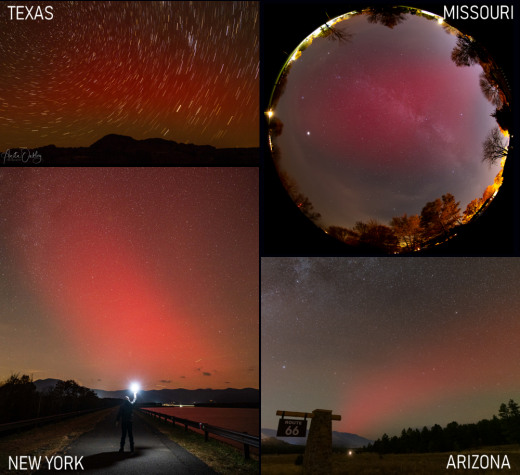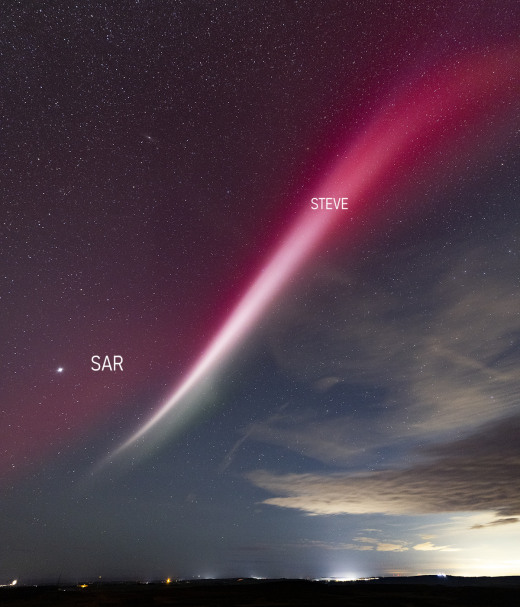[ Skywatchers ] [ Main Menu ]
47729
From: Eve, [DNS_Address]
Subject: EARTH'S RING CURRENT JUST SPRANG A LEAK: During this weekend's strong
|
During this weekend's strong G3-class geomagnetic storm, low-latitude auroras spread as far south as Texas and Arizona. Upon further review, most of those lights were not auroras at all. Everything red in these photos is an "SAR":  "This was a new phenomenon to me," says Jeremy Perez, who took the Arizona photo. "I had never heard of SARs before, but I kept shooting anyway." SARs were discovered in 1956 at the beginning of the Space Age. Researchers didn't know what they were and unwittingly gave them a misleading name: "Stable Auroral Red arcs" or SARs. In fact, SARs are neither stable nor auroras. Auroras appear when charged particles rain down from space, hitting the atmosphere and causing it to glow. SARs form differently. They are a sign of heat energy leaking into the upper atmosphere from Earth's ring current system–a donut- shaped circuit carrying millions of amps around our planet. "On Nov. 5th, the ring current was pumped up for hours by the geomagnetic storm, with energy dissipating into these SAR arcs," says Jeff Baumgardner of Boston University's Center for Space Physics. "It was a global event. Our cameras registered SAR activity from Italy to New Zealand." Recent research has linked SARs to another phenomenon that is not an aurora: STEVE. The mauve ribbon in the sky was not originally thought to have anything to do with Earth's ring current. Yet in 2015, observers in New Zealand caught a bright red SAR transforming itself into STEVE. Mark Savage may have seen the same thing happen on Nov 5th when an SAR apparently gave birth to STEVE over of Northumberland, UK:  "The entire process took about 10 minutes," says Savage. This roughly matches the timescale of an SAR-to-STEVE transition observed over Canada in April 2022. "The connection between STEVE and SARs is still elusive," cautions Carlos Martinis, a leading researcher in the field at Boston University. "Sometimes SARs evolve into STEVE--but not always. This is a very active field of research, involving citizen scientists and researchers." more SAR images: from Chris Cook of Borrego Springs, California; from Todd Bush of Banner Elk, North Carolina; from Ronnie Sherrill of Troutman, North Carolina; from George Preoteasa of Milford, PA; from David Blanchard of Wupatki National Monument, Arizona; from Hunter Outten of Laurel, Delaware; from Caryl Bohn of West Oak, Nebraska (at spaceweather.com link as time passes one can find the images in the archive date of November 7, 2023) |
47739
From: ryan, [DNS_Address]
Subject: Re: EARTH'S RING CURRENT JUST SPRANG A LEAK: During this weekend's...
|
If you've not yet been introduced, we'd love you to meet STEVE. new one for me... STEVE — Strong Thermal Emission Velocity Enhancement — is an aurora-like glow that often accompanies the northern lights, yet is a distinct phenomenon, according to the American Geophysical Union (AGU). STEVE was discovered between 2015 and 2016, not by professional astronomers or physicists, but by citizen scientists in Canada chasing the aurora, according to the first study published on STEVE in Science Advances in 2018. Now, researchers are studying STEVE with vigor, and keeping a close eye on the night sky to see it themselves. What is STEVE? STEVE is a streak of purplish light in the night sky that's similar to an aurora. In fact, STEVE has only ever been observed in conjunction with an aurora. That's because both phenomena are thought to be created by the same space weather events, according to the European Space Agency (ESA). When energized particles from the sun crash into Earth, our magnetic field redirects the particles toward the north and south poles. The electrically charged particles then enter Earth's atmosphere, exciting gas atoms and molecules and generating the aurora borealis (northern lights) and the aurora australis (southern lights). The process is similar to how neon lights work: When the molecules and atoms get "excited" by electrons, they must return to their original energy (ground state) and do so by releasing the energy as photons (light). At the same time, some of these solar emissions (in the form of super-speedy streams of plasma) heat gas in the upper atmosphere, and that's what creates STEVE, according to the National Oceanic and Atmospheric Administration (NOAA). Thus, STEVE is hot, glowing gas. |
Responses:
None
47738
From: georg, [DNS_Address]
Subject: Re: EARTH'S RING CURRENT JUST SPRANG A LEAK: During this weekend's...
|
years ago some fellow name John White wrote a book about theories of the earth tumbling into a new spin state due to our transiting a region of space that we encounter over long periods of time ... where will the new poles be? any thoughts |
Responses:
None
[ Skywatchers ] [ Main Menu ]